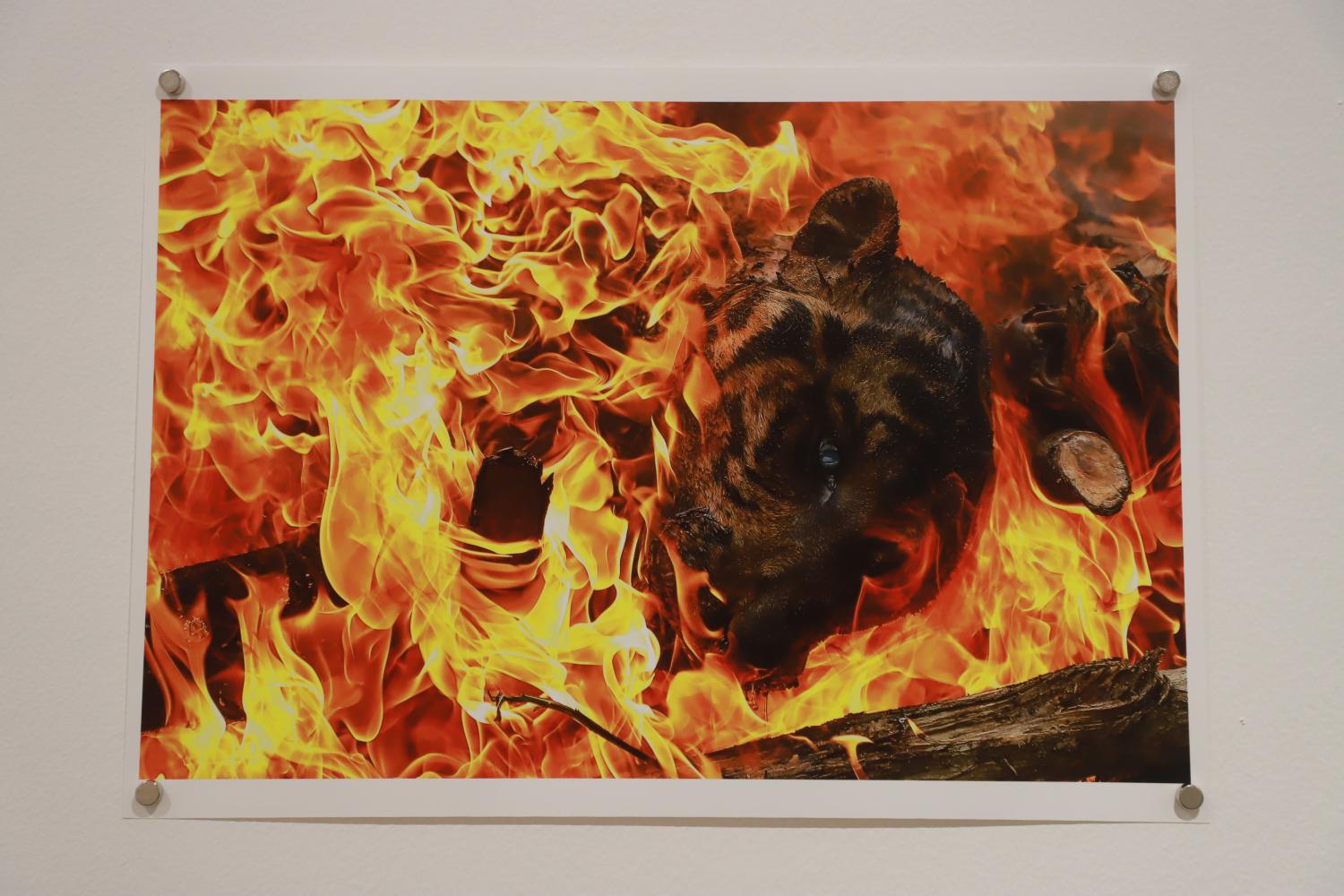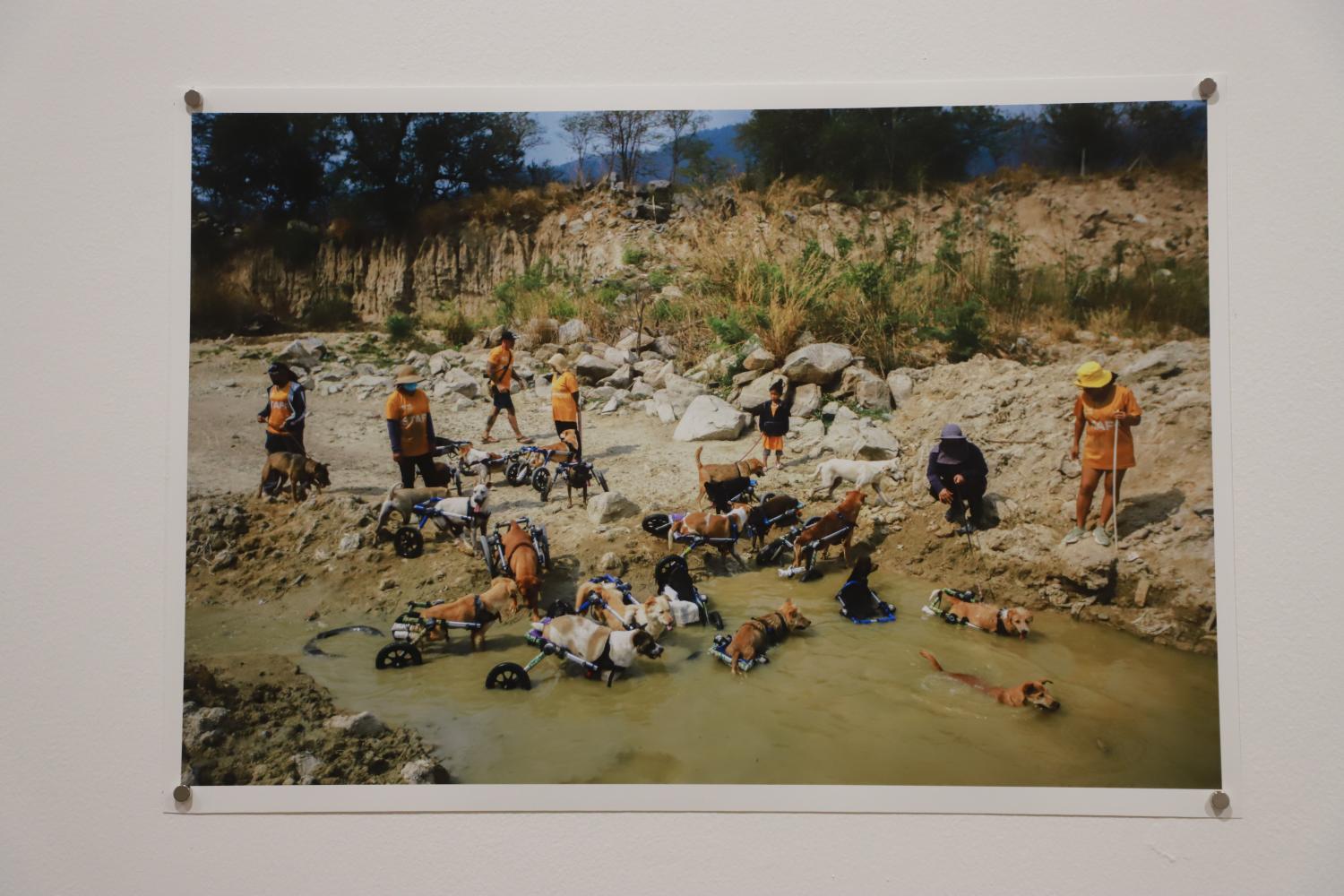
A philosopher in Ayutthaya is concerned about the future of the Kingdom. He closes his eyes to concentrate and his spirit travels from Ayutthaya to present-day Thailand. The first thing he sees is fireworks. Since fireworks are typically used for celebration, the philosopher believes he has arrived in a civilised country.
This short story was created to introduce visitors to the photo event "Landing In Utopia Exhibition". The image of the fireworks is actually a poster. The fireworks that the fictional philosopher sees were lit by protesters at a rally in the Din Daeng district of Bangkok. If the philosopher had taken a closer look, he would have seen policemen wearing bulletproof helmets and holding shields and weapons.
Curated by Charinthorn Rachurutchata and Sakchai Lalit, "Landing In Utopia Exhibition" showcases photos captured by 21 photographers from leading media outlets. The photos were taken at various events in Thailand and are displayed without captions, allowing viewers to interpret them in their own way.
"When I saw the fireworks photo, I thought about a sci-fi novel. It looked surreal and chaotic. The photo depicts people in their struggles to survive and dreams of a better society. Attempting to present photojournalism from different photographers in the same exhibition was a challenge. All photos were selected for their aesthetics and their ability to narrate stories," said Charinthorn.
A photo of disabled dogs playing in a pool of water can bring joy to animal lovers. However, the photo also highlights the issue of stray animals which requires organisations to spend time, manpower and money to take care of them.

One amusing photo was captured at an Um Phra Dam Nam ceremony, meaning Carrying The Buddha Image While Diving, in Phetchabun province. In the photo, attendees are holding umbrellas upside down, using them as containers to catch giveaway items that are tossed to attendees. Visitors who have never been to the ceremony may wonder what is happening in the photo.
There are many photos which not only captivate viewers with their aesthetics but also make them think about the issues behind the photos. For instance, one photo depicts the burning of a stuffed tiger head, which is an illegal item. It is devastating to see wild animals being made into decorative items instead of being left free in nature. Another photo showcases an oil spill from an underwater pipeline on a beach in Rayong province. The photo looks like a scene from a sci-fi movie with authorities wearing white chemical-resistant splash suits, examining the oil spill. The photo stimulates viewers to think about environmental issues.
The two curators of the exhibition have different backgrounds. Sakchai has been a photojournalist at the Associated Press for over 30 years. Meanwhile, Charinthorn began her career as a photographer at Cheeze magazine. She is best known as the first Thai photographer to win the World Press Photo Award in the Southeast Asia and Oceania region, Open Format category, for her project titled The Will To Remember. Unfortunately, when Life visited the photo exhibition on the opening day, Sakchai was too busy to participate in the event.
The Will To Remember showcases photos of two significant events -- the Oct 6, 1976, massacre and the pro-democracy rallies in which Charinthorn participated from 2020 to 2022. In the project, the photos of the Oct 6 massacre were torn apart and then repaired using a Japanese technique called Kintsugi, which involves using lacquer and gold powder. The philosophy behind Kintsugi is to repair damaged pieces without hiding or erasing the damage. Instead, it emphasises the damaged elements.

Charinthorn shared that her inspiration for creating The Will To Remember came from listening to a programme in which US-based Thai scholar Thongchai Winichakul, who was at the Oct 6 massacre, discussed the event.
"Thongchai expressed concern that if he passes away, the memory of the massacre would vanish with him," explained Charinthorn. "His sad expression touched me, so I committed myself to remembering the massacre although I had limited knowledge at that time.
"When I found out I had won the World Press Photo Award, I was screaming and running around wildly. I believe that not every judge knew the Kintsugi technique and its philosophy. Many people advised me to make changes after seeing the project. However, I firmly believed in the philosophy of Kintsugi and I did not create this project with the intention of participating in a competition. I crafted it because I wanted to remember the massacre."
While the photos of the massacre depict violence and cruelty, the repaired photos symbolise hope.

"I believed that The World Press Photo does not aim to portray terrible situations even though many photos contain violence. The World Press Photo seeks hope or a solution to these issues. I employed the Kintsugi technique because I did not want to conceal the past. Our country can still progress while acknowledging our history. We should not ignore or forget about our past," said Charinthorn.
The Will To Remember was exhibited in 65 cities in 25 countries including several countries in Southeast Asia. Unfortunately, no one has organised an exhibition for this award-winning project in Thailand.
Although her project has not been exhibited in Thailand, Charinthorn has an idea for her upcoming project which will involve disappearing monuments related to the Siamese revolution of 1932. However, she realises that this work, too, will never be displayed in Thailand.
"I create work that relates to political issues because I want to express myself and criticise society. It is sad that fear has enveloped many artists, preventing them from doing the things they want to do. This situation forces some artists to display their work abroad. Thailand has lost so much potential art due to fear of getting into trouble. They are afraid of using their imagination to create certain types of artwork. As a result, Thailand's art industry cannot fully develop," she said.
As the curator of the "Landing In Utopia Exhibition", Charinthorn is pleased that the photo gallery, HOP – Hub Of Photography, provided a space to exhibit photojournalism.

"In Thailand, photojournalism has limited visibility in media outlets. HOP – Hub Of Photography aims to support a photojournalism exhibition at Seacon Square Srinagarindra which will be an excellent opportunity for young visitors. I hope viewers will pay attention to these photos rather than consider them as elements of news stories. This is a time for forming a new government, a time when people can dream about a better future and a better society. If the photos reflect certain issues or inspire viewers to interpret or imagine, it would be wonderful," said Charinthorn.
"Landing In Utopia Exhibition" runs at HOP – Hub Of Photography in Seacon Square Srinagarindra until June 25. Admission is free. For more information, visit facebook.com/hubofphotographybangkok.









